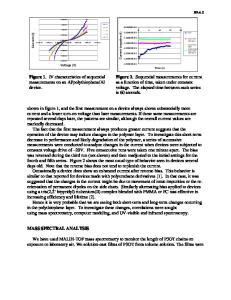Poly-3-thienylboronic acid: a chemosensitive derivative of polythiophene
- PDF / 1,165,313 Bytes
- 7 Pages / 595.276 x 790.866 pts Page_size
- 103 Downloads / 245 Views
ORIGINAL PAPER
Poly-3-thienylboronic acid: a chemosensitive derivative of polythiophene Yulia Efremenko 1 & Vladimir M. Mirsky 1 Received: 29 June 2020 / Revised: 13 July 2020 / Accepted: 14 July 2020 # The Author(s) 2020
Abstract Poly-3-thiopheneboronic acid was synthesized by electrochemical polymerization from 3-thienylboronic acid dissolved in the mixture of boron trifluoride diethyl etherate and acetonitrile. Cyclic voltammetry during electropolymerization shows oxidative and reductive peaks growing in each next cycle. An investigation by scanning electron microscopy displayed the polymer layer like a highly flexible film of 110 nm thick with grains of 60–120 nm in size. Strong negative solvatochromic effect was observed. Optical spectra of poly-3-thienylboronic acid at different potentials and pH were studied. Potential cycling leads to a well reversible electrochromic effect. At pH 7.4, the increase of potential leads to the decrease in the absorption band at 480 nm and to the rise in the absorption band at 810 nm with an isosbestic point at 585 nm. Spectroelectrochemical behavior of poly-3thienylboronic acid and polythiophene was compared. Binding of sorbitol at fixed electrode potential leads to an increase in the absorbance in the shortwave band and to the decrease in the longwave band; the effect depends on the electrode potential and pH. Perspectives of application of poly-3-thienylboronic acid as new chemosensitive material are discussed. Keywords Chemosensitive conducting polymers . Polythiophene . Poly-3-thienylboronic acid . Spectroelectrochemistry . Sorbitol sensing
Introduction Extraordinary properties of conducting polymers (CP) [1–3] resulted in wide applications in different fields of science and industry: electroluminescent and electrochromic devices [4], membranes and ion exchangers [5, 6], materials for energy technologies [7, 8] chemical sensors [9] and biosensors [10], artificial muscles [11], electrocatalysis [12]. A large number of CP such as polyacetylene, poly(3,4-ethylenedioxythiohene) (PEDOT), polyaniline, polypyrrole, polythiophene (PTh), and their derivatives have acquired a widespread recognition due to their inherent conductivity as well as tunable electrochemical, acid-base, and optical properties. Among these CP, the Electronic supplementary material The online version of this article (https://doi.org/10.1007/s10008-020-04767-z) contains supplementary material, which is available to authorized users. * Vladimir M. Mirsky [email protected] 1
Nanobiotechnology Department, Institute of Biotechnology, Brandenburg University of Technology Cottbus – Senftenberg, Senftenberg, Germany
polymers with PTh backbone belong to the most explored ones, both theoretically and experimentally [13, 14]. This class of CP attracts close attention because of the high chemical and longtime stability, high electrical conductivity, and ease of structural modification. Numerous applications of PTh and its derivatives in chemical sensing were suggested [15, 16]. Based on PTh nitrogen dioxide sensors wit
Data Loading...











